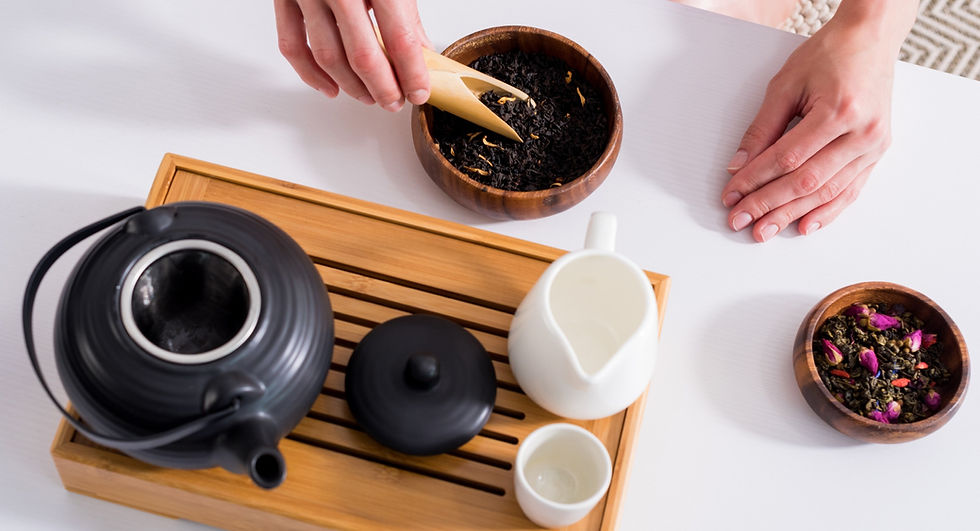Brewing your tea
- TeaDeya

- Apr 9, 2019
- 4 min read
Updated: Apr 16, 2019
The teapot – form and material are decisive
The ideal teapot is bulbous because tea needs space in order to develop its flavour when steeping. The opening of the spout however should be rather small to allow only little air to enter and to better conserve the heat.
Whether you prefer a teapot made of glass, china or ceramics is a question of your personal preferences. Glass teapots have the big advantage not to take on the taste of the tea and are easy to clean. This is why you may prepare different sorts of tea in the same teapot.
China teapots mostly have beautiful ornaments which - particularly in the Japanese tradition - are indispensable for tea ceremonies. The Chinese tea tradition however imperatively expects the use of a ceramics teapot. This pottery should not be glazed in order to allow enough oxygen to enter the pot when the tea is being brewed. But unglazed ceramics strongly take in the taste of the tea and do emit it again when preparing other tea sorts. There is the patina which remains in the pot and which can hardly be removed, even using hot water. Still you should not use any detergents for cleaning teapots, the rests of these tending to infiltrate the flavour of the tea even more.
Those of you being really accurate about tea should take a different teapot for every grade they drink. You may thus leave the patina inside the teapot - and tea experts confirm that only the patina is creating the ultimate flavour when it comes to brewing a delicious tea.

The filter – a separate filter for every tea grade
Tea is traditionally being brewed by putting loose leaves into the teapot. Once the tea has steeped for the proper amount of time, the leaves have to be separated from the liquid. The use of sieves will avoid the need to filter the tea. You should however take into consideration that tea tends to absorb external smells and flavours. A cotton sieve will therefore very soon have taken in the aromatic mixture and colour of your favourite tea sorts. This is why we are recommending to use a separate cotton sieve for each tea family.
Stainless steel is a suitable material for sieves and tea eggs as stainless steel is flavourless and can easily be cleaned. They should be selected so large that the tea has sufficient space to swell. Only in this way the fine aromas develop properly. It may however be laborious to remove the patina from stainless steel filters. Therefore better equally choose separate filters or sieves for every tea grade even for the stainless steel option.
Tea fans who love many different grades will best be served by paper filters. After steeping these can easily be disposed of into the compost together with the tea leaves.
No matter which option you will choose – be sure of always leaving enough room for the leaves to swell so that the flavours can develop to their best.
The water quality – fresh water for fine flavours
The water quality is decisive to transform simple tea into a pure tasting experience. As a general rule tea should always be made with fresh water due to the contained oxygen influencing decisively the final taste of the tea. When boiling the water it loses oxygen and that is why it should not have been in the pipe or the water boiler for too long or should not have been boiled already once before.
In Europe tap water is a strictly inspected good and can be used for brewing tea almost everywhere without any hesitation. It is however worthwhile checking the hardness of your drinking water as lime binds the bitter substances of the tea and affects its aroma and colour. Water as from a lime content of 10° eH (approx. 14 g lime/100 l water) should be filtered. We recommend the usage of a current commercial water filtering system, e.g. from Brita (http://www.brita.com).
Storage – tea can in place of paper bag
It is essential to assure a proper storage of the tea so that the precious leaves can conserve freshness and flavour. Once purchased you should take the leaves out of the paper bags used for the shipment and pack them into suitable receptacles.
Tightly closed cans are the ideal storage mode protecting the tea from humidity, light and external smells. The cans should stand away from sun and warmth, i. e. neither next to a heating nor to a sunny window.
Tea leaves do easily take up external flavours. This is why a spice cupboard or the fridge should equally be avoided for the storage of tea cans as too many different flavours could be soaked in by the tea. You should stick to the principle: rather buy small quantities and enjoy your freshly delivered tea.
Preparing Tea – amount of leaves and infusion time
The variety of tea grades implies that there are quite a range of different ways to prepare tea. The correct water temperature, the exact amount of tea and the infusion time - the connoisseur knows how to celebrate the perfect tea brewing. But you can do it just as well in a simple way and test out which amount of tea and steeping time you will need to obtain your individually favourite tea. And very soon you will know exactly how to prepare it and you will not have to ponder over it any more.




Comments